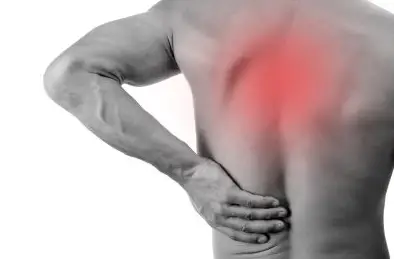The treatment of low back pain is complex and multifactorial. Essentially, the characteristics of the patient must be taken into consideration to optimize management and accelerate healing.
Although it is always better to consult, we will share concrete solutions to cure your low back pain. Based on our experience as physiotherapists and the results of thousands of patients, these tips will guide you on the path to recovery.
Low back pain: Short reminder
La lumbago is one of the most common ailments. The lumbago is the second causes disability in adults. Symptoms can range from a dull ache to a sharp, stabbing pain, and can be made worse by activities like bending, lifting, or sitting for long periods of time.
La lumbago can be caused by a problem with the spine, more specifically:
- intervertebral discs
- the muscles surrounding the spine
- the joints connecting the vertebrae together
- the nerves emerging from the spine and innervating the lower limbs
- the sacroiliac joint, which connects the bottom of the spine to the pelvis.
This can lead to conditions such as:
- herniated disc
- lumbar arthritis
- facet osteoarthritis
- sciatica ou cruralgia
- spondylolisthesis
- narrow lumbar canal
- myofascial syndrome
- etc.
Obviously the traitement de la lumbago varies depending on the underlying cause. This is why it is recommended to consult a health professional for appropriate care.
However, general measures can certainly reduce your symptoms, make your nights sleep easier and improve your quality of life. We present them in the next section.
How to relieve lower back pain (What to do exactly?)
You suffer from low back pain, and the pain limits you on a daily basis.
What can you do to reduce your lower back pain and resume your activities?
Generally, we start with conservative treatments aimed at relieving you, in addition to restoring your movements and maximizing your function. A trained therapist may use one of the following techniques to help you:
Note: In some cases, low back pain results from a serious impairment (like the following situations). Consultation with a health professional and urgent medical intervention are then prioritized.
List (non-exhaustive) of conservative treatments
- Heat and/or ice (video explanation)
- Mckenzie method (video explanation)
- Massage and mobilization of a qualified therapist
- Joint manipulation
- Therapeutic exercises (kinesitherapy or physiotherapy)
- Meditation techniques
- Breathing techniques
- Yoga and/or Pilates
- Weight loss
There are also alternative treatments used in the treatment of low back pain. Although they demonstrate an absence of scientific evidence, they are often used, sometimes with success.
List (non-exhaustive) of alternative treatments
When conservative treatments do not work, many turn to alternative medicine. Although they are not supported by solid scientific evidence, we observe in some cases an improvement of the symptomatology thanks to the following approaches:
- Natural products
- Myotherapy
- Acupuncture
- Cupping (suction cups)
- Quinton Plasma
- Percutaneous hydrotomy
- therapeutic yoga
- Craniosacral therapy
It is also possible to self-treat in the comfort of your own home by using certain anti-back pain accessories. However, it should be remembered that these tools generally provide temporary relief, and should be used sparingly. Among the products recommended by our professionals, we have:
- acupressure mat
- Heated lumbar belt
- Postural T-Shirts
- Ergonomic back cushion
- massage gun
- Spinal decompression table
- Decompression back stretcher
List (non-exhaustive) of invasive treatments
Finally, invasive treatments are sometimes considered when the pain persists and previous treatments have proven ineffective. In general, it is rare to have recourse to these methods in the case of simple low back pain. It is more in the presence of nerve or spinal cord compression that this subject is broached with the patient.
Anyway, it is advisable to consult your doctor who will be able to guide you in the process.
What about natural remedies?
Although they are not supported by solid scientific evidence, several natural products and grandmother's remedies are used to treat lower back pain, especially for their anti-inflammatory power.
Here is a non-exhaustive list of plants and essential oils that are effective in controlling pain and inflammation. The products are available on the site Country. Use promo code LOMBAFIT15 if you wish to obtain one of the following products, or any remedy aimed at relieving your symptoms and improving your quality of life:
- Turmeric. Thanks to its antioxidant and anti-inflammatory powers very powerful, turmeric is one of the most used plants in a culinary and therapeutic context. The composition of turmeric is essentially made of essential oils, vitamins (B1, B2, B6, C, E, K) and trace elements. But it is to its composition rich in curcumin and curcuminoids that we owe them and calm skin of this spice.
- Ginger. In addition to the special flavor it brings to the kitchen and its aphrodisiac properties, ginger is a root well known for its anti-inflammatory powers. the gingerol gives it its anti-inflammatory action. It is an active component acting on the inflammatory pain related to chronic joint inflammatory diseases, including rheumatoid arthritis, lupus, rheumatic diseases, etc. It has been proven that this active element is also effective in acting on the inflammation linked to arthritis and sciatica. Ginger also has other benefits thanks to its high potassium content and its richness in trace elements (calcium, magnesium, phosphorus, sodium) and vitamins (provitamin and vitamin B9).
- Omega-3s. Omega-3s are polyunsaturated fatty acids that play a very important role in the functioning of our body. They are provided by food in three natural forms: docosahexaenoic acid (DHA), alpha linolenic acid (ALA) and eicosapentaenoic acid (EPA). Beyond their action on the brain and the cardiovascular system, omega-3s prove very effective against inflammation. Indeed, they have the ability to act on the inflammatory mechanisms in osteoarthritis by slowing down cartilage destruction, thus they reduce the intensity of osteoarthritis pain. Since sciatica is most often linked to inflammation secondary to a herniated disc, it can also respond to omega-3s if you consume them regularly.
- Lemon eucalyptus. Eucalyptus is a plant most often used in the form of herbal tea or essential oil. She would have anti-inflammatory effects which give it the ability to act on the bone and joint pain in general and the pain of sciatica in particular.
- wintergreen. Wintergreen is a shrub from which a very interesting essential oil is extracted. It is one of the most used essential oils in aromatherapy. This oil extracted from the shrub bearing the same name, is used in massage to relieve sciatica and act like a analgesic. Indeed, it provides a heating effect thanks to its ability toactivate blood circulation locally.







